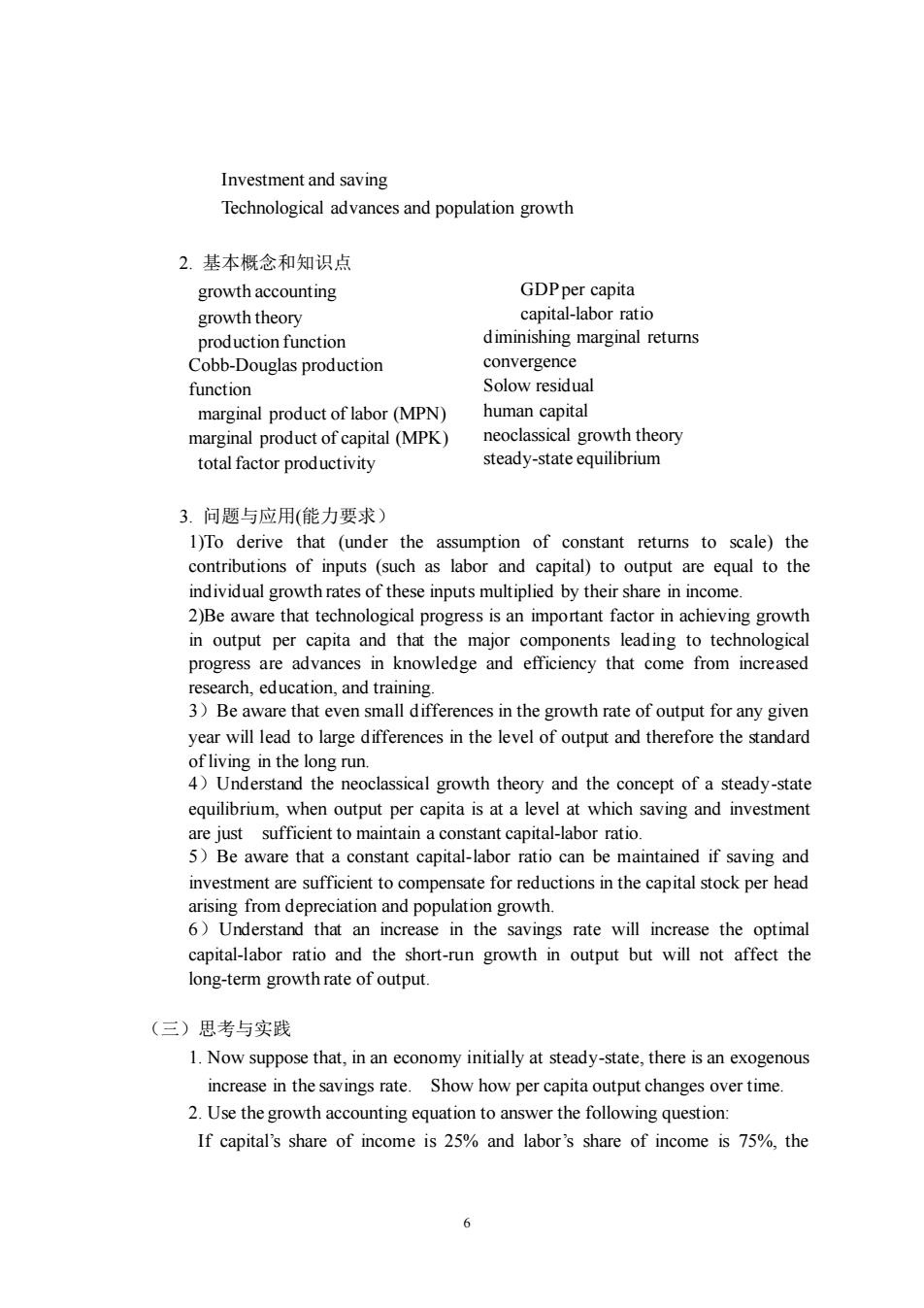正在加载图片...

Investment and saving Technological advances and population growth 2.基本概念和知识点 growth accounting GDPper capita growth theory capital-labor ratio production function diminishing marginal retumns Cobb-Douglas production function marginal product of labor (MPN) human capital marg inal product of capital(MPK) neoclassical growth theory total factor productivity steady-state equilibrium 3.问题与应用(能力要求) 1)To derive that (under the assumption of constant retums to scale)the contributions of inputs (such as labor and capital)to output are equal to the individual growth rates of these inputs multiplied by their share in income. 2)Be aware that technological progress is an important facto in achie owth in output per capita and tha th majo onents ad ing to technologic progress are advances in knowledge and efficiency that come from increased research.education,and training. 3)Be aware that even small differences in the growth rate of output for any given year will lead to large differences in the level of output and therefore the standard Understand equilibrium,when output per capita is at a level at which saving and investment are just sufficient to maintain a constant capital-labor ratio. 5)Be aware that a constant capital-labor ratio can be maintained if saving and investment are sufficient to compensate for reductions in the capital stock per head epreciation and populati dthat an inenease in the savings rate will increase the optimal n growth capital-labor ratio and the short-run growth in output but will not affect the long-term growth rate of output (三)思考与实践 1.Now suppose that,in an economy initially at steady-state,there is an exogenous increase in the savings rate.Show how per capita output changes over time 2.Use the growth accounting equation to answer the following question: If capital's share of income is 25%and labor's share of income is 75%,the 6 6 Investment and saving Technological advances and population growth 2. 基本概念和知识点 growth accounting growth theory production function Cobb-Douglas production function marginal product of labor (MPN) marginal product of capital (MPK) total factor productivity GDP per capita capital-labor ratio diminishing marginal returns convergence Solow residual human capital neoclassical growth theory steady-state equilibrium 3. 问题与应用(能力要求) 1)To derive that (under the assumption of constant returns to scale) the contributions of inputs (such as labor and capital) to output are equal to the individual growth rates of these inputs multiplied by their share in income. 2)Be aware that technological progress is an important factor in achieving growth in output per capita and that the major components leading to technological progress are advances in knowledge and efficiency that come from increased research, education, and training. 3)Be aware that even small differences in the growth rate of output for any given year will lead to large differences in the level of output and therefore the standard of living in the long run. 4)Understand the neoclassical growth theory and the concept of a steady-state equilibrium, when output per capita is at a level at which saving and investment are just sufficient to maintain a constant capital-labor ratio. 5)Be aware that a constant capital-labor ratio can be maintained if saving and investment are sufficient to compensate for reductions in the capital stock per head arising from depreciation and population growth. 6)Understand that an increase in the savings rate will increase the optimal capital-labor ratio and the short-run growth in output but will not affect the long-term growth rate of output. (三)思考与实践 1. Now suppose that, in an economy initially at steady-state, there is an exogenous increase in the savings rate. Show how per capita output changes over time. 2. Use the growth accounting equation to answer the following question: If capital’s share of income is 25% and labor’s share of income is 75%, the